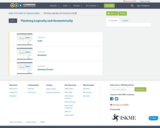
84 Results


Topics List for this Lesson: Points, Lines, Planes, and AnglesTriangles Plus Similarity and ProportionsPerimeter, Area, and CircumferenceVolume and Surface Area
- Subject:
- Mathematics
- Material Type:
- Full Course
- Author:
- Jillian Miller
- Megan Simmons
- Stefanie Holmes
- Jessica Chambers
- Brad Fox
- Heather Doncaster
- Ashley Morgan
- Misty Anderson
- Date Added:
- 07/08/2021

- Subject:
- Mathematics
- Material Type:
- Full Course
- Provider:
- Pearson
- Date Added:
- 10/06/2016

Surface Area and Volume
Type of Unit: Conceptual
Prior Knowledge
Students should be able to:
Identify rectangles, parallelograms, trapezoids, and triangles and their bases and heights.
Identify cubes, rectangular prisms, and pyramids and their faces, edges, and vertices.
Understand that area of a 2-D figure is a measure of the figure's surface and that it is measured in square units.
Understand volume of a 3-D figure is a measure of the space the figure occupies and is measured in cubic units.
Lesson Flow
The unit begins with an exploratory lesson about the volumes of containers. Then in Lessons 2–5, students investigate areas of 2-D figures. To find the area of a parallelogram, students consider how it can be rearranged to form a rectangle. To find the area of a trapezoid, students think about how two copies of the trapezoid can be put together to form a parallelogram. To find the area of a triangle, students consider how two copies of the triangle can be put together to form a parallelogram. By sketching and analyzing several parallelograms, trapezoids, and triangles, students develop area formulas for these figures. Students then find areas of composite figures by decomposing them into familiar figures. In the last lesson on area, students estimate the area of an irregular figure by overlaying it with a grid. In Lesson 6, the focus shifts to 3-D figures. Students build rectangular prisms from unit cubes and develop a formula for finding the volume of any rectangular prism. In Lesson 7, students analyze and create nets for prisms. In Lesson 8, students compare a cube to a square pyramid with the same base and height as the cube. They consider the number of faces, edges, and vertices, as well as the surface area and volume. In Lesson 9, students use their knowledge of volume, area, and linear measurements to solve a packing problem.
- Subject:
- Geometry
- Mathematics
- Material Type:
- Unit of Study
- Provider:
- Pearson

Lesson OverviewStudents find the area of a triangle by putting together a triangle and a copy of the triangle to form a parallelogram with the same base and height as the triangle. Students also create several examples of triangles and look for relationships among the base, height, and area measures. These activities lead students to develop and understand a formula for the area of a triangle.Key ConceptsTo find the area of a triangle, you must know the length of a base and the corresponding height. The base of a triangle can be any of the three sides. The height is the perpendicular distance from the vertex opposite the base to the line containing the base. The height can be found inside or outside the triangle, or it can be the length of one of the sides.You can put together a triangle and a copy of the triangle to form a parallelogram with the same base and height as the triangle. The area of the original triangle is half of the area of the parallelogram. Because the area formula for a parallelogram is A = bh, the area formula for a triangle is A = 12bh.Goals and Learning ObjectivesDevelop and explore the formula for the area of a triangle.
- Subject:
- Geometry
- Material Type:
- Lesson Plan
- Date Added:
- 09/21/2015
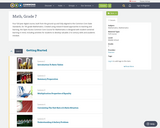
Four full-year digital course, built from the ground up and fully-aligned to the Common Core State Standards, for 7th grade Mathematics. Created using research-based approaches to teaching and learning, the Open Access Common Core Course for Mathematics is designed with student-centered learning in mind, including activities for students to develop valuable 21st century skills and academic mindset.
- Subject:
- Mathematics
- Material Type:
- Full Course
- Provider:
- Pearson
- Date Added:
- 10/06/2016

Algebraic Reasoning
Type of Unit: Concept
Prior Knowledge
Students should be able to:
Add, subtract, multiply, and divide rational numbers.
Evaluate expressions for a value of a variable.
Use the distributive property to generate equivalent expressions including combining like terms.
Understand solving an equation or inequality as a process of answering a question: which values from a specified set, if any, make the equation or inequality true?
Write and solve equations of the form x+p=q and px=q for cases in which p, q, and x are non-negative rational numbers.
Understand and graph solutions to inequalities x<c or x>c.
Use equations, tables, and graphs to represent the relationship between two variables.
Relate fractions, decimals, and percents.
Solve percent problems included those involving percent of increase or percent of decrease.
Lesson Flow
This unit covers all of the Common Core State Standards for Expressions and Equations in Grade 7. Students extend what they learned in Grade 6 about evaluating expressions and using properties to write equivalent expressions. They write, evaluate, and simplify expressions that now contain both positive and negative rational numbers. They write algebraic expressions for problem situations and discuss how different equivalent expressions can be used to represent different ways of solving the same problem. They make connections between various forms of rational numbers. Students apply what they learned in Grade 6 about solving equations such as x+2=6 or 3x=12 to solving equations such as 3x+6=12 and 3(x−2)=12. Students solve these equations using formal algebraic methods. The numbers in these equations can now be rational numbers. They use estimation and mental math to estimate solutions. They learn how solving linear inequalities differs from solving linear equations and then they solve and graph linear inequalities such as −3x+4<12. Students use inequalities to solve real-world problems, solving the problem first by arithmetic and then by writing and solving an inequality. They see that the solution of the algebraic inequality may differ from the solution to the problem.
- Subject:
- Algebra
- Mathematics
- Material Type:
- Unit of Study
- Provider:
- Pearson

Students write and solve inequalities in order to solve two problems. One of the problems is a real-world problem that involves selling a house and paying the real estate agent a commission. The second problem involves the relationship of the lengths of the sides of a triangle.Key ConceptsIn this lesson, students again use algebraic inequalities to solve word problems, including real-world situations. Students represent a quantity with a variable, write an inequality to solve the problem, use the properties of inequality to solve the inequality, express the solution in words, and make sure that the solution makes sense.Students explore the relationships of the lengths of the sides of a triangle. They apply the knowledge that the sum of the lengths of any two sides of a triangle must be greater than the length of the third side to solve for the lengths of sides of a triangle using inequalities. They solve the inequality for the length of the third side.Goals and Learning ObjectivesUse an algebraic inequality to solve problems, including real-world problems.Use the properties of inequalities to solve an inequality.
- Subject:
- Algebra
- Geometry
- Material Type:
- Lesson Plan
- Date Added:
- 09/21/2015

Constructions and Angles
Unit Overview
Type of Unit: Concept
Prior Knowledge
Students should be able to:
Use a protractor and ruler.
Identify different types of triangles and quadrilaterals and their characteristics.
Lesson Flow
After an initial exploratory lesson involving a paper folding activity that gets students thinking in general about angles and figures in a context, the unit is divided into two concept development sections. The first section focuses on types of angles—adjacent, supplementary, complementary, and vertical—and how they are manifested in quadrilaterals. The second section looks at triangles and their properties, including the angle sum, and how this affects other figures.
In the first set of conceptual lessons, students explore different types of angles and where the types of angles appear in quadrilaterals. Students fold paper and observe the angles formed, draw given angles, and explore interactive sketches that test many cases. Students use a protractor and ruler to draw parallelograms with given properties. They explore sketches of parallelograms with specific properties, such as perpendicular diagonals. After concluding the investigation of the angle types, students move on to the next set.
In the second set of conceptual development lessons, students focus on triangles. Students again fold paper to create figures and certain angles, such as complementary angles.
Students draw, using a protractor and ruler, other triangles with given properties. Students then explore triangles with certain known and unknown elements, such as the number of given sides and angles. This process starts with paper folding and drawing and continues with exploration of interactive sketches. Students draw conclusions about which cases allow 0, 1, 2, or an infinite number of triangles. In the course of the exploration, students discover that the sum of the measure of the interior angles of a triangle is 180°. They also learn that the sum of the measures of the interior angles of a quadrilateral is 360°. They explore other polygons to find their angle sum and determine if there is a relationship to angle sum of triangles. The exploration concludes with finding the measure of the interior angles of regular polygons and speculating about how this relates to a circle.
Lastly, students solve equations to find unknown angle measures. Using their previous experience, students find the remaining angle measures in a parallelogram when only one angle measure is given. Students also play a game similar to 20 Questions to identify types of triangles and quadrilaterals. Having completed the remaining lessons, students have a four-day Gallery to explore a variety of problems.
The unit ends with a unit assessment.
- Subject:
- Geometry
- Mathematics
- Material Type:
- Unit of Study
- Provider:
- Pearson
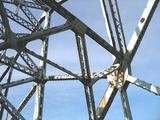
Students learn to classify triangles by the size of the angles and the measures of the sides.Key ConceptsTriangles are polygons with three sides.Scalene triangles have all sides with a different length and all angles with a different measure.Isosceles triangles have two sides with the same length and two angles with the same measure.Equilateral triangles have all sides with the same length and all angles with the same measure.Acute triangles have all angles with a measure less than 90°.Obtuse triangles have one angle with a measure greater than 90°.Right triangles have one angle with a measure of 90°.ELL: Keep in mind that consistency at the beginning is very important as students begin to learn and apply math vocabulary.Goals and Learning ObjectivesExplore conditions that result in triangles.Identify types of triangles based on the measure of the angles or the measures of the sides.
- Subject:
- Geometry
- Material Type:
- Lesson Plan
- Date Added:
- 09/21/2015
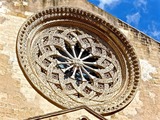
Lesson OverviewStudents explore different polygons by drawing them, measuring angles, and manipulating interactive sketches to find the angle sum for any polygon. Students also explore the angle measures in regular polygons.Key ConceptsThe angle sum in a triangle is 180°. A quadrilateral can be composed of two triangles, so the angle sum of a quadrilateral is 360°.The number of triangles that compose a polygon is two less than the number of sides (angles). The sum of the interior angles in a polygon with n sides is 180° (n – 2).Goals and Learning ObjectivesFind angle sums in polygons.Generalize to find the angle sum for any polygon.Find interior angle measures for regular polygons.
- Subject:
- Geometry
- Material Type:
- Lesson Plan
- Date Added:
- 09/21/2015
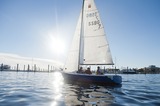
Students explore properties of triangles. They fold paper to make a triangle and measure its angles. Students also draw triangles with given conditions.Key ConceptsThe sum of the measures of the angles in a triangle is always 180°.Given different side measures and/or angle measures, some scenarios will create triangles and others will not. Students explore various cases and draw conclusions about which conditions create triangles and why.Goals and Learning ObjectivesDraw triangles with given conditions.Find the sum of the measures of the angles of a triangle.Explore conditions that result in triangles.
- Subject:
- Geometry
- Material Type:
- Lesson Plan
- Date Added:
- 09/21/2015

Zooming In On Figures
Unit Overview
Type of Unit: Concept; Project
Length of Unit: 18 days and 5 days for project
Prior Knowledge
Students should be able to:
Find the area of triangles and special quadrilaterals.
Use nets composed of triangles and rectangles in order to find the surface area of solids.
Find the volume of right rectangular prisms.
Solve proportions.
Lesson Flow
After an initial exploratory lesson that gets students thinking in general about geometry and its application in real-world contexts, the unit is divided into two concept development sections: the first focuses on two-dimensional (2-D) figures and measures, and the second looks at three-dimensional (3-D) figures and measures.
The first set of conceptual lessons looks at 2-D figures and area and length calculations. Students explore finding the area of polygons by deconstructing them into known figures. This exploration will lead to looking at regular polygons and deriving a general formula. The general formula for polygons leads to the formula for the area of a circle. Students will also investigate the ratio of circumference to diameter ( pi ). All of this will be applied toward looking at scale and the way that length and area are affected. All the lessons noted above will feature examples of real-world contexts.
The second set of conceptual development lessons focuses on 3-D figures and surface area and volume calculations. Students will revisit nets to arrive at a general formula for finding the surface area of any right prism. Students will extend their knowledge of area of polygons to surface area calculations as well as a general formula for the volume of any right prism. Students will explore the 3-D surface that results from a plane slicing through a rectangular prism or pyramid. Students will also explore 3-D figures composed of cubes, finding the surface area and volume by looking at 3-D views.
The unit ends with a unit examination and project presentations.
- Subject:
- Geometry
- Mathematics
- Material Type:
- Unit of Study
- Provider:
- Pearson
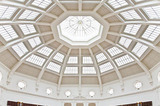
Students find the area of regular polygons, recalling what they already know about the area of geometric shapes and generalizing a formula for any regular polygon.Key ConceptsStudents will recall what they already know about the area of geometric shapes and apply that to find the area of regular polygons. Any regular polygon can be divided into congruent isosceles triangles. If the length from the center to the midpoint of a side (the apothem) is known, the area of the triangles and the area of the polygon can be found. Students will see the similarities between the area of a polygon and derive the formula for the area of a circle.GoalsReview area of triangles, rectangles, and parallelograms.Find the area of regular polygons.Generalize an area formula for any regular polygon.ELL: This lesson offers students a rich opportunity to learn academic vocabulary. Display the new terms in writing somewhere visible in the classroom so that you can refer to them. Allow ELLs to use their bilingual dictionaries to help with understanding the terms. When possible, have ELLs discuss the terms in their language of choice with other ELLs who share the same primary language.
- Subject:
- Geometry
- Material Type:
- Lesson Plan
- Date Added:
- 09/21/2015

Students critique their work from the Self Check and redo the task after receiving feedback. Students then take a quiz to review the goals of the unit.Key ConceptsStudents understand how to find the area of figures such as rectangles and triangles. They have applied that knowledge to finding the area of composite figures and regular polygons. The area of regular polygons was extended to understand the area of a circle. Students also applied ratio and proportion to interpret scale drawings and redraw them at a different scale.GoalsCritique and revise student work.Apply skills learned in the unit.Understand two-dimensional measurements:Area of composite figures, including regular polygons.Area and circumference of circles.Interpret scale drawings and redraw them at a different scale.SWD: Make sure all students have the prerequisite skills for the activities in this lesson.Students should understand these domain-specific terms:composite figuresregular polygonsareacircumferencescale drawingstwo dimensionalIt may be helpful to preteach these terms to students with disabilities.ELL: As academic vocabulary is reviewed, be sure to repeat it and allow students to repeat after you as needed. Consider writing the words as they are being reviewed. Allow enough time for ELLs to check their dictionaries if they wish.
- Subject:
- Geometry
- Material Type:
- Lesson Plan
- Date Added:
- 09/21/2015
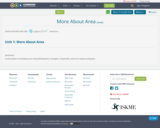
Lesson plans on finding area of parallelograms, triangles, trapezoids, and non-regular polygons.
- Subject:
- Mathematics
- Material Type:
- Homework/Assignment
- Lesson Plan
- Date Added:
- 05/02/2014

(Nota: Esta es una traducción de un recurso educativo abierto creado por el Departamento de Educación del Estado de Nueva York (NYSED) como parte del proyecto "EngageNY" en 2013. Aunque el recurso real fue traducido por personas, la siguiente descripción se tradujo del inglés original usando Google Translate para ayudar a los usuarios potenciales a decidir si se adapta a sus necesidades y puede contener errores gramaticales o lingüísticos. La descripción original en inglés también se proporciona a continuación.)
Así como se utilizan movimientos rígidos para definir la congruencia en el Módulo 1, se agregan dilataciones para definir la similitud en el Módulo 2. Para poder discutir la similitud, los estudiantes primero deben comprender claramente cómo se comportan las dilataciones. Esto se hace en dos partes, al estudiar cómo las dilataciones producen dibujos de escala y razonando por qué las propiedades de las dilataciones deben ser ciertas. Una vez que las dilataciones se establecen claramente, se definen transformaciones de similitud y se examinan las relaciones de longitud y ángulo, lo que produce criterios de similitud triangular. Sigue una mirada profunda a la similitud dentro de los triángulos rectos, y finalmente el módulo termina con un estudio de trigonometría del triángulo recto.
Encuentre el resto de los recursos matemáticos de Engageny en https://archive.org/details/engageny-mathematics.
English Description:
Just as rigid motions are used to define congruence in Module 1, so dilations are added to define similarity in Module 2. To be able to discuss similarity, students must first have a clear understanding of how dilations behave. This is done in two parts, by studying how dilations yield scale drawings and reasoning why the properties of dilations must be true. Once dilations are clearly established, similarity transformations are defined and length and angle relationships are examined, yielding triangle similarity criteria. An in-depth look at similarity within right triangles follows, and finally the module ends with a study of right triangle trigonometry.
Find the rest of the EngageNY Mathematics resources at https://archive.org/details/engageny-mathematics.
- Subject:
- Geometry
- Mathematics
- Material Type:
- Module
- Provider:
- New York State Education Department
- Provider Set:
- EngageNY
- Date Added:
- 07/03/2014
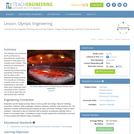
The lesson begins by introducing Olympics as the unit theme. The purpose of this lesson is to introduce students to the techniques of engineering problem solving. Specific techniques covered in the lesson include brainstorming and the engineering design process. The importance of thinking out of the box is also stressed to show that while some tasks seem impossible, they can be done. This introduction includes a discussion of the engineering required to build grand, often complex, Olympic event centers.
- Subject:
- Applied Science
- Architecture and Design
- Education
- Engineering
- Geometry
- Mathematics
- Technology
- Material Type:
- Activity/Lab
- Lesson Plan
- Provider:
- TeachEngineering
- Provider Set:
- TeachEngineering
- Author:
- Abigail Watrous
- Denali Lander
- Janet Yowell
- Katherine Beggs
- Melissa Straten
- Tod Sullivan
- Date Added:
- 09/18/2014
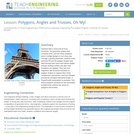
Students take a close look at truss structures, the geometric shapes that compose them, and the many variations seen in bridge designs in use every day. Through a guided worksheet, students draw assorted 2D and 3D polygon shapes and think through their forms and interior angles (mental “testing”) before and after load conditions are applied. They see how engineers add structural members to polygon shapes to support them under compression and tension, and how triangles provide the strongest elemental shape. A PowerPoint® presentation is provided. This lesson prepares students for two associated activities that continue the series on polygons and trusses.
- Subject:
- Geometry
- Mathematics
- Material Type:
- Lesson
- Provider:
- TeachEngineering
- Author:
- Andi Vicksman
- Maia Vadeen
- Malinda Zarske
- Nathan Coyle
- Russell Anderson
- Ryan Sullivan
- Sabina Schill
- Date Added:
- 02/07/2017
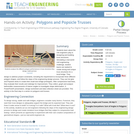
Students learn about the role engineers play in designing and building truss structures. Simulating a real-world civil engineering challenge, student teams are tasked to create strong and unique truss structures for a local bridge. They design to address project constraints, including the requirement to incorporate three different polygon shapes, and follow the steps of the engineering design process. They use hot glue and Popsicle sticks to create their small-size bridge prototypes. After compressive load tests, they evaluate their results and redesign for improvement. They collect, graph and analyze before/after measurements of interior angles to investigate shape deformation. A PowerPoint® presentation, design worksheet and data collection sheet are provided. This activity is the final step in a series on polygons and trusses.
- Subject:
- Geometry
- Mathematics
- Material Type:
- Activity/Lab
- Provider:
- TeachEngineering
- Author:
- Andi Vicksman
- Maia Vadeen
- Malinda Zarske
- Nathan Coyle
- Russell Anderson
- Ryan Sullivan
- Sabina Schill
- Date Added:
- 02/07/2017